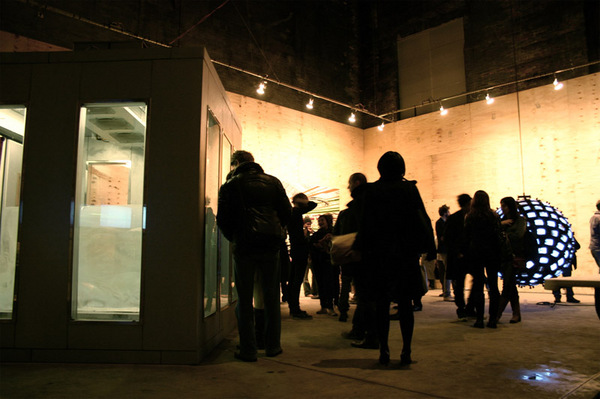This is an archive of the ArtCat Zine, 2007-2009. Please visit our new project, IDIOM.
Tavares Strachan at The Boiler
Tavares Strachan
The Boiler - 191 N. 14th Street, Brooklyn NY.
7 March - 19 April 2009
A 4.5-ton block of ice clinically lit by humming fluorescents and cooled within a solar-powered freezer, Tavares Strachan’s The Distance Between What We Have and What We Want, 2004-06 went on view Saturday at The Boiler, Pierogi Gallery’s immense additional space newly opened in Williamsburg. Strachan’s project takes center stage alongside others of ambitious scale by Yoon Lee and Jonathan Schipper.
At twenty-degrees Fahrenheit, Strachan’s stolid work sits brimming with narrative—social, political, and most obviously, environmental. Trace the ice en route (via FedEx) in July of 2006, from Alaska to the Bahamas, where Strachan lived as child, fascinated by ideas of snow and ice. There, the block’s first artistic iteration materialized as an educational tool for students at Albury Sayle Primary School in Nassau. His arctic fragment served as locus for conversations on mythmaking, as well as a flag-raising ceremony and other performances. Its relocation became a gesture of globalization, dissolving boundaries between disparate climates and sovereignties, reverberating the nation’s independence from the United Kingdom thirty-three years earlier.
By converting sunlight, inimical counterpart of The Distance Between..., his frozen matter resists a kind of death by displacement in its durational performance. If, as Robert Smithson believed, “entropy contradicts the usual notion of a mechanistic world view,” Strachan contradicts entropy, creating a necessary reliance on the mechanical in doing so. Roxy Paine’s Erosion Machine, 2005 comes to mind. Yet while Paine’s glass-and-steel sandblasting machine accelerates human inscription towards unimaginable severity, Strachan’s process stabilizes the damage. The ice is a conservational case study, memorializing the environment as we know it through an earnest attempt to sustain the unsustainable.
The installation glows, flanked by twin flatscreens displaying live climatic information for Alaska and the Bahamas. Yet another video feed displays the roof-mounted solar panels; the city skyline peeks from beyond the building’s edge. Nearly forty feet overhead, fans ripple altered Bahamian flags. Strachan belabors the ice-object, as if to thoroughly demystify it through a hyper-contextualization within, to borrow Smithson’s terminology, both site and non-site. Immoderate perhaps, still, uncertainties remain. Strachan’s ice ages undetectably. Distance grows greater.
ZINE
HOME
TIPS / COMMENTS
CATEGORIES
CONTRIBUTORS
- Greg Afinogenov
- B. Blagojevic
- Adda Birnir
- Susannah Edelbaum
- Julie Fishkin
- Paddy Johnson
- Jessica Loudis
- Christopher Reiger
- Andrew Robinson
- Peter J. Russo
- Blythe Sheldon
- S.C.Squibb
- Hrag Vartanian

